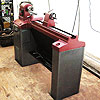I'm building a workbench based on the Vertas (center tray) design.
Because of the limitations of my shop - the 1 3/4" slabs will be about 9" wide x 62" long with 1/2" tenons on the ends (so the top will be 61 inches showing). The end tenons will fit into the end aprons. The side aprons will be glued on, probably with biscuits, just to keep the top of everything lined up while the glue dries.
I've got the slabs ripped to 9" width. It was tough getting the big slab over the TS - but once I ripped the slab in half (and half the weight) - things went pretty easy.
Now I need to cut the 72" slabs down to length and rabbet the end. I'm not opposed to using a spline if I have to - but I'd prefer no metal fasteners (otherwise I could just lag screw the aprons on).
Are the slabs too big to crosscut and rabbet on the TS? Even my longest miter fence (48") is too short to use an end stop - so how do I ensure they are EXACTLY the same length?
I'm open to suggestions - anybody got a bright idea or some experience in this kind of thing?
TIA-




 Reply With Quote
Reply With Quote





